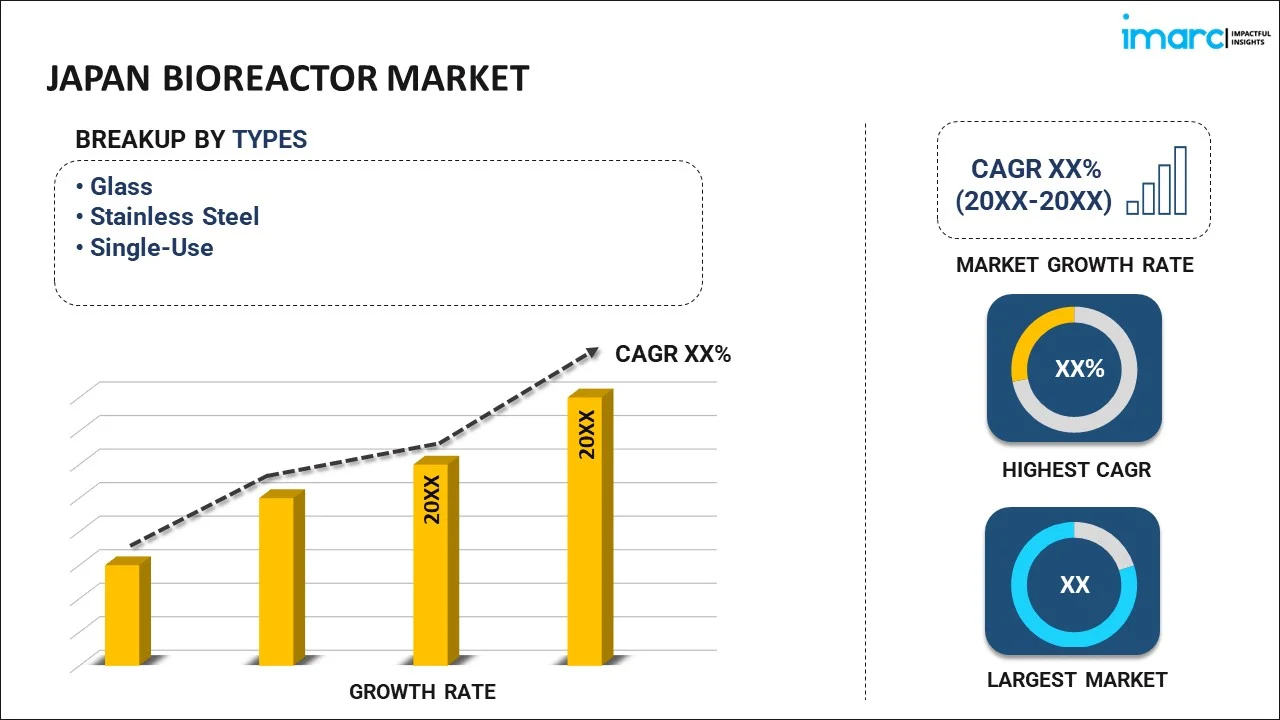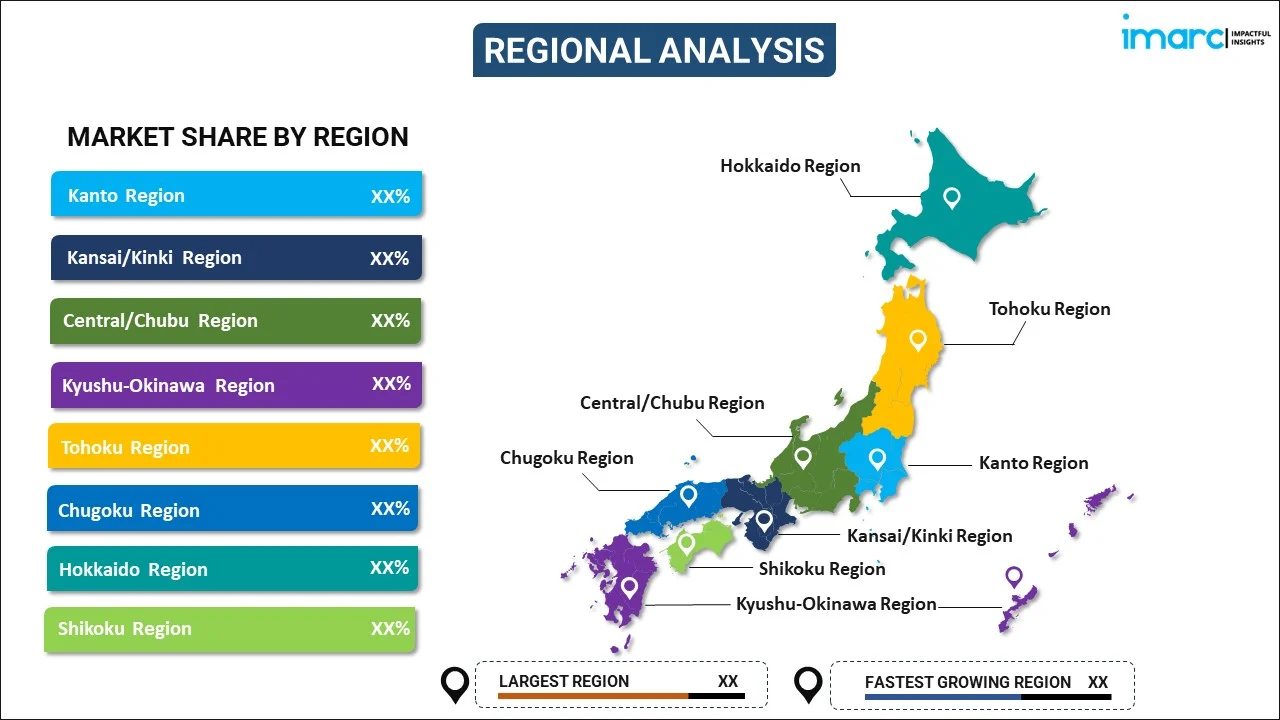
Japan Bioreactor Market Report by Type (Glass, Stainless Steel, Single-Use), Usage (Lab-Scale Production, Pilot-Scale Production, Full-Scale Production), Scale (5L-20L, 20L-200L, 200L-1500L, Above 1500L), Control Type (Manual, Automated), and Region 2025-2033
Market Overview:
Japan bioreactor market size reached USD 497.4 Million in 2024. Looking forward, IMARC Group expects the market to reach USD 1,328.1 Million by 2033, exhibiting a growth rate (CAGR) of 10.3% during 2025-2033. The continuous advancements in bioprocessing techniques, such as single-use bioreactors, perfusion systems, and automated controls, which increase the efficiency and scalability of bioreactor operations, are driving the market.
|
Report Attribute
|
Key Statistics
|
|---|---|
|
Base Year
|
2024 |
|
Forecast Years
|
2025-2033 |
|
Historical Years
|
2019-2024
|
| Market Size in 2024 | USD 497.4 Million |
| Market Forecast in 2033 | USD 1,328.1 Million |
| Market Growth Rate (2025-2033) | 10.3% |
A bioreactor is a specialized device used in biotechnology and microbiology to cultivate and control the growth of microorganisms, cells, or tissues under carefully monitored conditions. It serves as a controlled environment where factors like temperature, pH, oxygen levels, and nutrient supply can be regulated to optimize the growth and production of desired biological products. Bioreactors play a crucial role in various fields, including pharmaceuticals, food and beverage production, and environmental remediation. In pharmaceuticals, they are used to produce antibiotics, vaccines, and therapeutic proteins. In the food industry, bioreactors can be employed for fermentation processes like brewing and yogurt production. They are also vital in wastewater treatment, where microorganisms are used to break down pollutants. Bioreactors come in various designs, from small benchtop models for laboratory research to large-scale industrial systems. They enable scientists and engineers to study biological processes, develop new products, and efficiently produce valuable compounds in a controlled and reproducible manner, making them a cornerstone of modern biotechnology.
Japan Bioreactor Market Trends:
The bioreactor market in Japan is poised for substantial growth in the coming years due to a confluence of key drivers. Firstly, the increasing demand for biopharmaceuticals has been a pivotal factor. As the regional population ages and healthcare needs rise, there is a growing need for efficient bioprocessing techniques, which bioreactors provide. Secondly, advancements in bioreactor technology, such as single-use bioreactors and cell culture technologies, have significantly enhanced productivity and flexibility in biopharmaceutical manufacturing. These innovations cater to the dynamic needs of the industry, driving adoption and market expansion. Furthermore, regulatory agencies are increasingly emphasizing the importance of quality control and consistency in bioprocessing. Bioreactors, with their precise control over environmental conditions, facilitate compliance with these stringent regulations, making them indispensable in the biopharmaceutical sector. In addition to this, the growing focus on sustainable production practices to enable the development of environmentally friendly bioprocesses is expected to drive the bioreactor market in Japan during the forecast period.
Japan Bioreactor Market Segmentation:
IMARC Group provides an analysis of the key Trends in each segment of the market, along with forecasts at the country level for 2025-2033. Our report has categorized the market based on type, usage, scale, and control type.
Type Insights:

- Glass
- Stainless Steel
- Single-Use
The report has provided a detailed breakup and analysis of the market based on the type. This includes glass, stainless steel, and single-use.
Usage Insights:
- Lab-Scale Production
- Pilot-Scale Production
- Full-Scale Production
A detailed breakup and analysis of the market based on the usage have also been provided in the report. This includes lab-scale production, pilot-scale production, and full-scale production.
Scale Insights:
- 5L-20L
- 20L-200L
- 200L-1500L
- Above 1500L
The report has provided a detailed breakup and analysis of the market based on the scale. This includes 5L-20L, 20L-200L, 200L-1500L, and above 1500L.
Control Type Insights:
- Manual
- Automated
A detailed breakup and analysis of the market based on the control type have also been provided in the report. This includes manual and automated.
Regional Insights:

- Kanto Region
- Kansai/Kinki Region
- Central/ Chubu Region
- Kyushu-Okinawa Region
- Tohoku Region
- Chugoku Region
- Hokkaido Region
- Shikoku Region
The report has also provided a comprehensive analysis of all the major regional markets, which include Kanto Region, Kansai/Kinki Region, Central/ Chubu Region, Kyushu-Okinawa Region, Tohoku Region, Chugoku Region, Hokkaido Region, and Shikoku Region.
Competitive Landscape:
The market research report has also provided a comprehensive analysis of the competitive landscape. Competitive analysis such as market structure, key player positioning, top winning strategies, competitive dashboard, and company evaluation quadrant has been covered in the report. Also, detailed profiles of all major companies have been provided.
Japan Bioreactor Market Report Coverage:
| Report Features | Details |
|---|---|
| Base Year of the Analysis | 2024 |
| Historical Period | 2019-2024 |
| Forecast Period | 2025-2033 |
| Units | Million USD |
| Scope of the Report | Exploration of Historical Trends and Market Outlook, Industry Catalysts and Challenges, Segment-Wise Historical and Future Market Assessment:
|
| Types Covered | Glass, Stainless Steel, Single-Use |
| Usages Covered | Lab-Scale Production, Pilot-Scale Production, Full-Scale Production |
| Scales Covered | 5L-20L, 20L-200L, 200L-1500L, Above 1500L |
| Control Types Covered | Manual, Automated |
| Regions Covered | Kanto Region, Kansai/Kinki Region, Central/ Chubu Region, Kyushu-Okinawa Region, Tohoku Region, Chugoku Region, Hokkaido Region, Shikoku Region |
| Customization Scope | 10% Free Customization |
| Post-Sale Analyst Support | 10-12 Weeks |
| Delivery Format | PDF and Excel through Email (We can also provide the editable version of the report in PPT/Word format on special request) |
Key Questions Answered in This Report:
- How has the Japan bioreactor market performed so far and how will it perform in the coming years?
- What has been the impact of COVID-19 on the Japan bioreactor market?
- What is the breakup of the Japan bioreactor market on the basis of type?
- What is the breakup of the Japan bioreactor market on the basis of usage?
- What is the breakup of the Japan bioreactor market on the basis of scale?
- What is the breakup of the Japan bioreactor market on the basis of control type?
- What are the various stages in the value chain of the Japan bioreactor market?
- What are the key driving factors and challenges in the Japan bioreactor?
- What is the structure of the Japan bioreactor market and who are the key players?
- What is the degree of competition in the Japan bioreactor market?
Key Benefits for Stakeholders:
- IMARC’s industry report offers a comprehensive quantitative analysis of various market segments, historical and current market Trends, market forecasts, and dynamics of the Japan bioreactor market from 2019-2033.
- The research report provides the latest information on the market drivers, challenges, and opportunities in the Japan bioreactor market.
- Porter's five forces analysis assist stakeholders in assessing the impact of new entrants, competitive rivalry, supplier power, buyer power, and the threat of substitution. It helps stakeholders to analyze the level of competition within the Japan bioreactor industry and its attractiveness.
- Competitive landscape allows stakeholders to understand their competitive environment and provides an insight into the current positions of key players in the market.
Need more help?
- Speak to our experienced analysts for insights on the current market scenarios.
- Include additional segments and countries to customize the report as per your requirement.
- Gain an unparalleled competitive advantage in your domain by understanding how to utilize the report and positively impacting your operations and revenue.
- For further assistance, please connect with our analysts.
 Inquire Before Buying
Inquire Before Buying
 Speak to an Analyst
Speak to an Analyst
 Request Brochure
Request Brochure
 Request Customization
Request Customization




.webp)




.webp)












